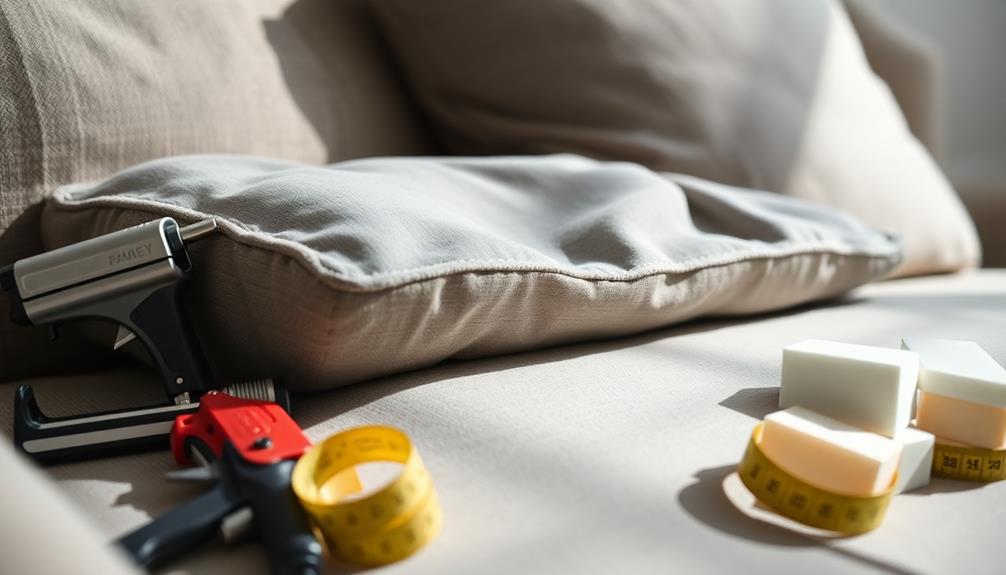To repair sagging sofa cushions, begin by unzipping the cushion covers. Remove the old stuffing and replace it with polyester fiberfill for added support. Be sure to fill the corners to maintain the cushion’s shape. Regularly flip and rotate the cushions to prevent uneven wear, and consider placing plywood underneath for extra firmness. Fluff the cushions regularly by shaking them out and lifting the corners to maintain their volume. Consistent maintenance, like vacuuming and cleaning, also helps extend their lifespan. If you’re interested in more effective tips and techniques, there is a lot more to discover to keep your sofa feeling fresh.
Key Takeaways
- Unzip the cushion cover, remove old stuffing, and replace it with polyester fiberfill for improved support and firmness.
- Flip and rotate cushions regularly to promote even wear and prevent additional sagging.
- Incorporate quilt batting around foam inserts to enhance comfort and stability.
- Vacuum cushions frequently to eliminate dust and debris, maintaining a clean seating area.
- Regularly fluff cushions by lifting corners and shaking them to restore volume and prevent compression.
Understanding Sagging Cushions
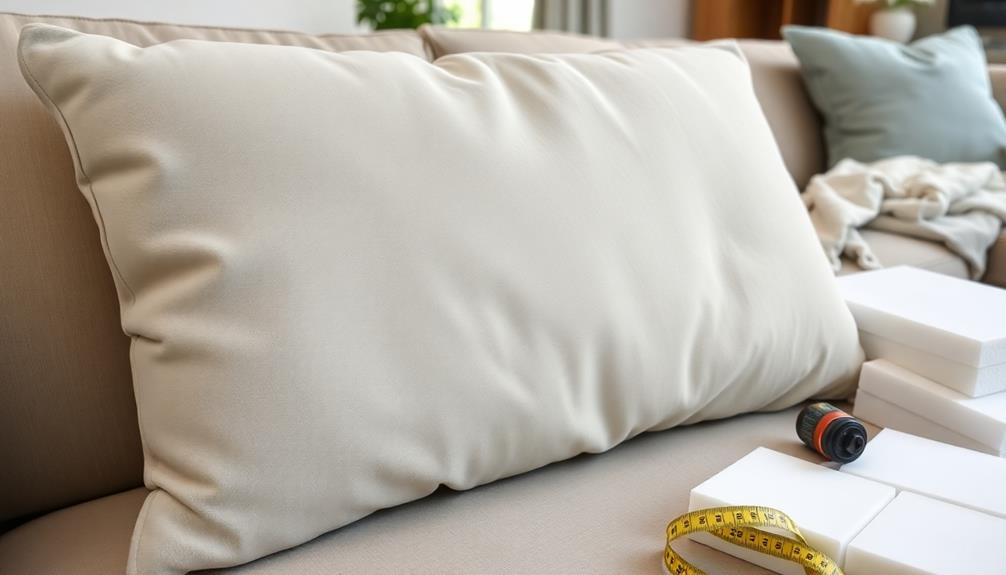
Sagging sofa cushions can be a common problem that affects both comfort and the overall look of your furniture. Over time, daily use compresses the foam and stuffing inside your couch cushions, leading to noticeable indentations that can diminish your seating experience.
Typically, the average lifespan of couch cushions is around five years, after which wear and tear become evident. To maintain a healthier indoor environment, consider regular vacuuming to remove dust and allergens that can contribute to cushion deterioration, as highlighted in best vacuums for dust removal in 2024.
If you've got non-removable cushions, you might find it more challenging to clean and maintain them, allowing dirt and debris to build up and worsen the sagging. Regular inspection is essential, especially if you have pets or frequently use your sofa, as these factors can accelerate the sagging process.
To prolong the life of your cushions, consider high-quality materials during your next purchase. Techniques like flipping and rotating your cushions can help distribute wear evenly, preventing uneven sagging.
Additionally, investing in couch cushion covers can protect against stains and dirt, further extending their lifespan. By understanding the dynamics of saggy couch cushions, you can take proactive steps to maintain both comfort and aesthetics in your living space.
Common Causes of Sagging

Over time, daily use takes a toll on your sofa cushions, leading to noticeable sagging. One of the primary culprits is the consistent weight distribution that compresses the foam cushion and stuffing materials. As you sit, the foam loses its firmness, creating visible indentations and sagging issues. If your cushions are made from poor-quality materials, this deterioration can happen even faster.
Additionally, certain factors, such as humidity and temperature changes, can also affect the longevity of your sofa cushions, similar to how cold medications can have varying effects on comfort and relief.
Regular maintenance is key; cushions that aren't flipped or fluffed can develop localized drooping, further exacerbating sagging. Additionally, attached cushions often experience uneven wear compared to removable ones, which you can adjust and maintain more easily.
If you have pets, they can greatly contribute to wear and tear on your sofa. Their weight and playful activities put extra pressure on the cushions, leading to faster sagging.
Understanding these common causes will help you address the problem effectively and prolong the life of your furniture. By recognizing how daily habits and external factors affect your sagging sofa, you can take proactive steps to keep your cushions looking and feeling like new.
Essential Tools and Materials
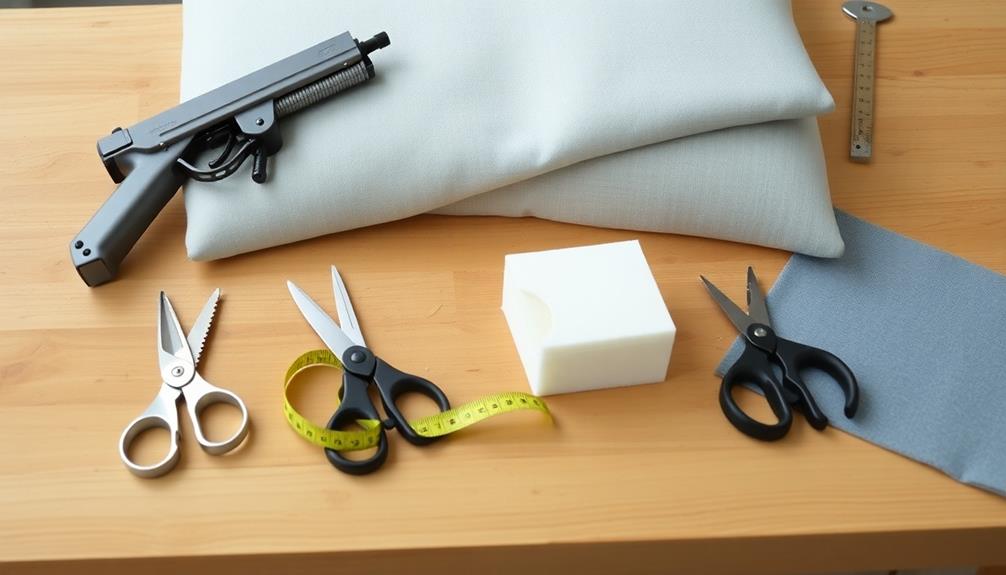
To fix those sagging sofa cushions, you'll need some essential tools and materials. Start by gathering scissors, zippers or seam rippers, and consider optional items like plastic trash bags for easier handling. Once you have your tools ready, carefully open the cushion seams using either the zippers or the seam ripper. Insert additional padding, such as foam or polyester fiberfill, to give the cushions their firmness back. For a more detailed guide on how to repair a sinking sofa, you can explore adding plywood or replacing worn-out springs to bolster the seating structure. Once you’ve added the necessary padding and the cushions regain their shape, carefully sew the seams back together to ensure everything stays in place. Regular maintenance, such as rotating the cushions and tightening any loose fabric, can help prolong the life of your sofa. For more comprehensive steps on *how to repair a sagging sofa*, you may also want to explore reinforcing the frame or upgrading the support system for a long-lasting fix.
It's also important to guarantee your selected materials are safe and comfortable for use, much like how proper diet includes fresh fruits is vital for pet care.
For materials, think about polyester fiberfill, quilt batting, or high-density foam, all of which offer cost-effective solutions to bring your cushions back to life.
Required Tools Overview
When tackling the issue of sagging sofa cushions, having the right tools and materials at your disposal makes the process much easier. To enhance your living space's air quality while you work, consider using an air purifier for a cleaner environment air purifier maintenance dos and don'ts.
Here's a quick overview of what you'll need to get started:
- Scissors for cutting materials
- Zippers for accessing cushion stuffing
- Vacuum for cleaning debris from under cushions
- Quilt batting for added comfort
- Plastic trash bag for easy cushion insertion
With these tools, you can effectively address the sagging problem. Use scissors to cut your quilt batting and foam pads to the appropriate size. Zippers will help you reach the stuffing within your cushions without hassle.
A vacuum is essential for removing any debris that may be hiding underneath, ensuring a clean workspace.
Don't forget to gather polyester fiberfill stuffing, which you can purchase in bulk, and consider incorporating high-density foam pads or even old bed pillows as additional stuffing materials.
A plastic trash bag can simplify the process of reinserting your cushions into their covers, making the task more efficient. With these items on hand, you're ready to restore your sofa cushions to their former glory!
Recommended Cushion Materials
Choosing the right materials is key to effectively restoring your sagging sofa cushions. Start with high-density foam, like 32D foam, which offers excellent stability and durability. This material is essential for long-term comfort, ensuring your cushions don't sag again soon after restoration.
Additionally, consider using essential oils for relaxation during the process, as they can create a calming environment while you work on your project.
Next, consider polyester fiberfill. It's an affordable option for cushion stuffing, typically available in 10lb boxes for around $19.97 at Walmart. Polyester fiberfill can help fluff up your cushions without breaking the bank.
To enhance support and comfort further, you can use quilt batting in conjunction with foam. Priced at about $7.97 per roll, quilt batting provides an additional layer that makes a noticeable difference in feel.
Don't forget about the tools you'll need, such as scissors for cutting your materials and zippers for accessing the cushion stuffing. A vacuum cleaner with upholstery attachments is also a must to clean existing cushions before you start, ensuring that dirt doesn't compromise your new stuffing.
With the right materials and tools, you'll be well on your way to reviving those sagging couch cushions!
Cost-Effective Solutions
Reviving your sagging sofa cushions doesn't have to break the bank. With a few cost-effective materials and tools, you can easily fix sagging couch cushions and give your couch a fresh look without splurging on a new couch.
Proper investment in home decor can also elevate your living space, similar to how budget planning can enhance financial health.
Here are some essential items you'll need:
- Polyester fiberfill stuffing (10lb box for about $19.97)
- Quilt batting (two rolls at approximately $7.97 each)
- Scissors for cutting materials
- Access to a zipper on your cushion covers
- Old bed pillows for extra stuffing
Investing around $35.91 in these materials can greatly enhance your couch's comfort and appearance. The polyester fiberfill provides the necessary support, while quilt batting adds an extra layer of comfort.
Plus, using old bed pillows as stuffing can further cut costs.
Step-by-Step Repair Process
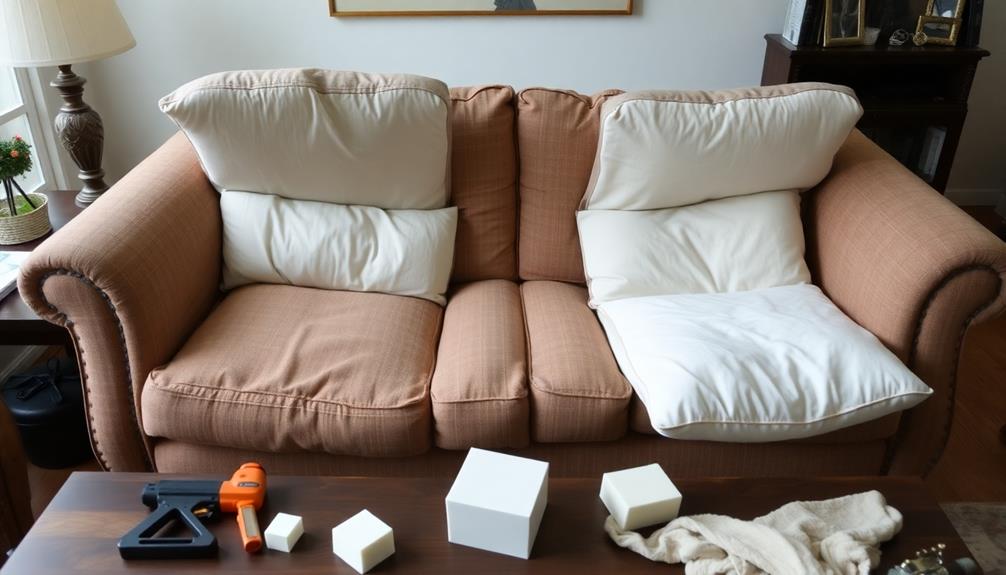
To tackle sagging sofa cushions effectively, start by unzipping the cushion cover to access the stuffing. Removing the old stuffing and filling it with polyester fiberfill or other supportive materials until it's adequately full is crucial for restoring comfort.
Incorporating techniques from design thinking principles can help you approach this process creatively and effectively. Make certain to fill the corners to guarantee uniformity. If you're using foam, wrap it with quilt batting before reinserting it into the cover. This will enhance comfort and support, allowing the foam to maintain its shape over time.
Next, consider inserting a plywood board under the cushions for additional support. This provides a firmer base and helps prevent further sagging. Once you've added the new stuffing, zip the cover tightly. If you find it difficult to reinsert the cushions, use a plastic trash bag to make the process smoother.
Don't forget to regularly flip and rotate the cushions to distribute wear evenly. This simple step can help maintain their shape and greatly extend their lifespan.
Techniques for Cushion Restoration
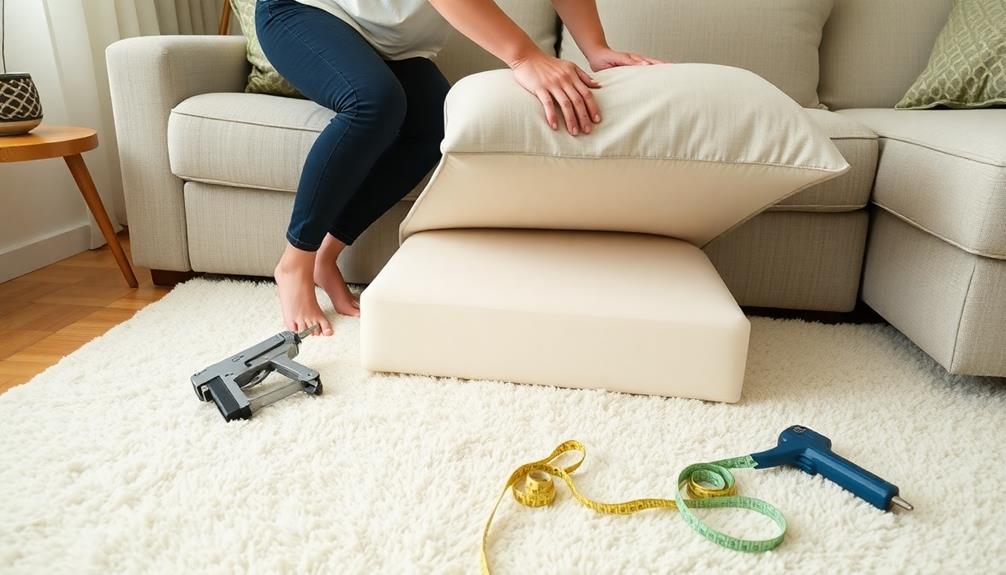
Restoring your sofa cushions can breathe new life into your living space and enhance your comfort. Here are some effective techniques to fix sagging cushions and bring back their original shape:
- Add polyester fiberfill or foam through zippers to restore firmness.
- Flip and rotate your cushions regularly to distribute wear evenly.
- Utilize quilt batting around foam inserts for added support and comfort.
- Insert a piece of plywood under the cushions for a firmer base.
- Regularly fluff and beat your cushions to rejuvenate the stuffing.
Maintaining Your Couch Cushions
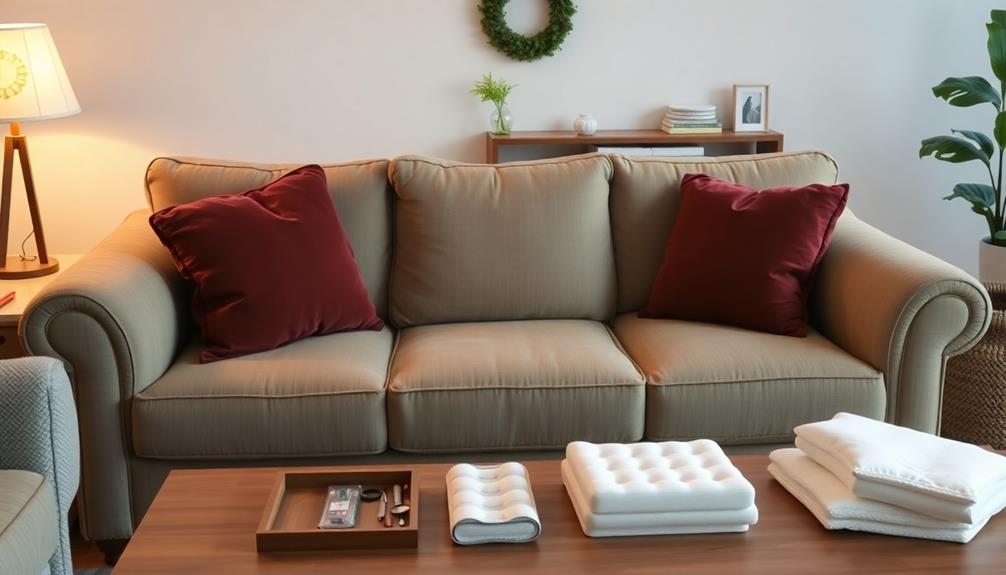
To keep your couch cushions in top shape, regularly fluff them to maintain their volume and prevent sagging.
Incorporating regular maintenance, similar to how preventive maintenance plans can extend appliance lifespans, can greatly enhance the longevity of your cushions.
Don't forget to check your cushion covers too; washing them can keep your seating area fresh and looking great.
Regular Fluffing Techniques
Although it might seem like a minor chore, regular fluffing of your couch cushions is crucial for keeping them in top shape. Fluffing not only helps redistribute stuffing but also prevents localized drooping, which can lead to a sagging sofa.
To guarantee comfort and longevity, you should fluff your cushions at least once a week, especially in areas that see a lot of use. Notably, much like the different brewing methods that can affect the quality of coffee, the way you care for your cushions can greatly influence their lifespan and comfort.
Understanding the mechanics of French press can enhance your overall experience, just as proper cushion maintenance can improve your seating comfort.
Here are some effective fluffing techniques:
- Grasp the cushion corners and lift them upward.
- Shake the cushions gently to loosen compressed stuffing.
- Flip and rotate cushions to encourage even wear.
- Use a vacuum cleaner with an upholstery attachment to remove debris before fluffing.
- Make it a part of your cleaning routine for better maintenance.
Cushion Cover Maintenance
Maintaining your couch cushions requires attention to the covers that protect them. Regular cushion cover maintenance is essential for ensuring cleanliness and prolonging the life of your couch. Here's how you can effectively care for your cushion covers:
| Maintenance Task | Frequency | Tips |
|---|---|---|
| Wash Removable Covers | Every 1-3 months | Use a gentle cycle and air-dry to avoid shrinkage. |
| Spot Clean Non-Removable | As needed | Use rubbing alcohol and always check care labels. |
| Vacuum Cushions | Weekly | Don't forget to vacuum under the cushions for allergens. |
| Inspect Under Cushions | Monthly | Remove debris that can cause odors and wear. |
| Apply Fabric Protectors | After Cleaning | Helps repel stains and spills for better appearance. |
Community Tips and Insights
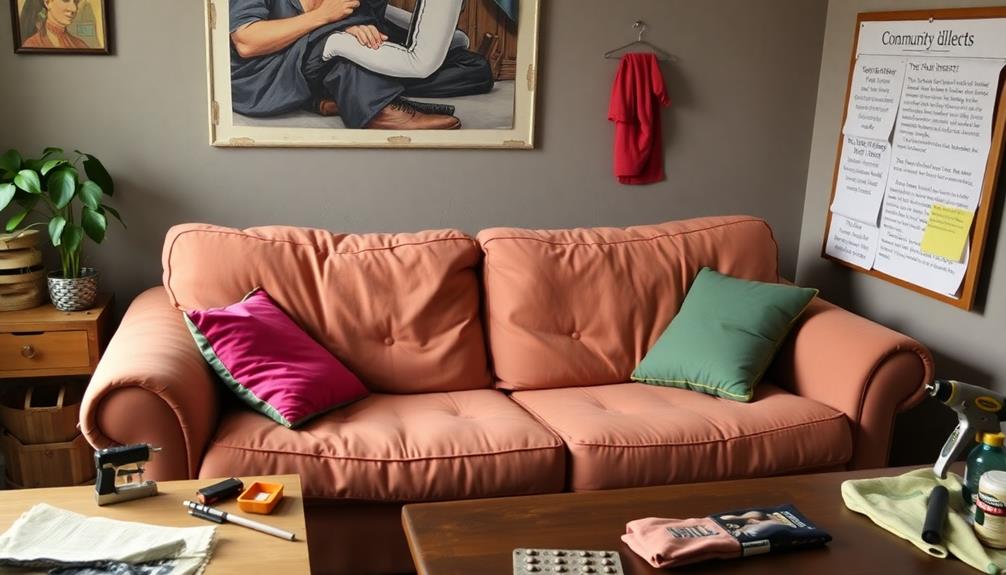
The community has come together to share valuable tips and insights for fixing sagging sofa cushions, revealing a wealth of creative solutions.
Here are some standout suggestions that could help you restore your couch to its former glory:
- Use old bed pillows or crib bumpers as unconventional stuffing materials. These items can provide added support and comfort, similar to well-draining soil essential for preventing root rot.
- Flip and rotate cushions regularly to guarantee even wear and prolong their life.
- Add extra stuffing, like polyester fiberfill, for improved firmness—many DIY enthusiasts recommend a 10lb box for around $20.
- Check for zippers in cushion covers; they allow for easy stuffing adjustments, enhancing your DIY repairs.
- Share before-and-after photos to inspire others and showcase your successful cushion restoration.
When to Seek Professional Help
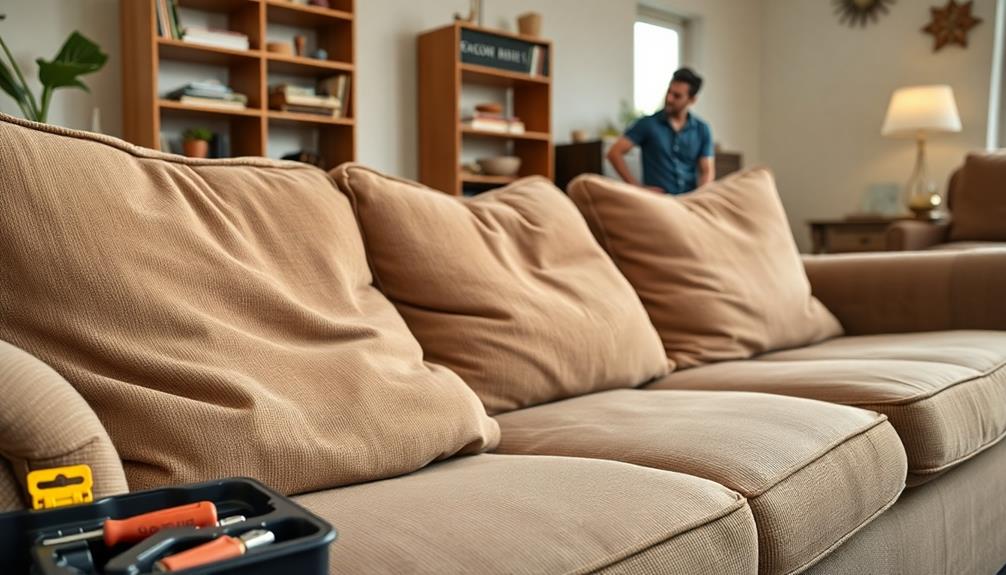
Recognizing when to seek professional help can save you time and frustration in restoring your sagging sofa cushions. If your DIY attempts, like adding stuffing or using plywood support, haven't produced satisfactory results, it's a clear sign to consult a professional.
Consider professional reupholstery services, especially if your sofa is heavily used or older. These experts can provide high-quality materials and craftsmanship, guaranteeing a durable and comfortable restoration.
If you notice issues with the structural integrity of your sofa, such as broken frames or springs, it's essential to get professional help. Ignoring these problems can lead to further damage and costly repairs down the road.
For significant sagging or uneven wear impacting comfort and aesthetics, a professional evaluation can offer tailored solutions that go beyond basic fixes.
Additionally, if dirt and debris have accumulated under the cushions, consider hiring professional cleaning services. They can rejuvenate the upholstery and enhance your sofa's appearance, making it look fresh and inviting again.
Don't hesitate to reach out for expert assistance when your sofa needs it; it'll save you time and secure the best results.
Frequently Asked Questions
How Can I Make My Sofa Cushions Firm Again?
To make your sofa cushions firm again, try adding high-density foam or polyester fiberfill. Regularly fluff, flip, and rotate them to evenly distribute wear, and consider using a board underneath for extra support.
How to Fix a Couch That Sinks in the Middle?
To fix a couch that sinks in the middle, try placing plywood underneath for support. Regularly rotate your cushions and consider adding high-density foam or fiberfill to restore firmness and comfort effectively.
What to Do When Couch Cushions Go Flat?
When your couch cushions go flat, you can add polyester fiberfill or foam for support. Regularly fluffing and rotating them can help too, ensuring even wear and extending their life considerably.
How Do I Keep My Couch Cushions From Pushing Out?
Cushion care's essential! To keep your couch cushions from pushing out, regularly fluff and rotate them. Consider using support boards or high-density foam inserts for firmness, and check for debris underneath to maintain even pressure.
Conclusion
In the end, rejuvenating your sagging sofa cushions can breathe new life into your living space, like a fresh coat of paint on a weathered canvas. By understanding the causes and employing simple repair techniques, you'll turn a droopy disaster into a cozy haven. Remember, a well-maintained couch not only supports your body but cradles your soul. So, roll up your sleeves and give your furniture the love it deserves—after all, it's more than just a seat; it's your sanctuary.
